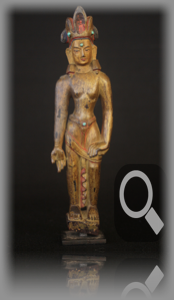A28. PHAGPA LOKESVARA, 20 CMS, 18TH CENTURY OR EARLIER
Images of Phagpa Lokesvara have been made in several media including ivory, bronze, but most frequently wood. The fact that these images followed such a rigid iconography suggested that they were in fact copies of a highly revered statue rather than images created by a sculptor constrained only by the prescriptions laid down in a particular sutra.
The original image was finally identified by Alsop and is discussed in his article “Phagpa Lokesvara of the Potala”, Orientations, April 1990, pp. 51-61.
Phagpa Lokesvara means “Noble Lord of the World” and the original image is to be found in a chapel known as the Phagpa Lhakhang. This chapel is the oldest and most sacred in the Potala Palace in Lhasa. All known examples are copies of this image. These images’ most conspicuous features include their simple tall three lobed crowns, their hair tied up and extending out on either side of the crowns, their bell shaped earrings, a rigid stance with the right arms pendant, the right hands in varada mudra, the left hands placed on the hips, naked upper torsos with long skirts or dhotis with a pleated border extending down between the legs, sashes extending from the right hips across the upper thighs and plain square plinths. They are also notable for their lack of jewellery and decoration.
Many images of Phagpa Lokesvara are incomplete because of the fragile nature of wood. The image under discussion is notable for its completeness, the relatively good condition of the painted lacquered surface and the unusual fact that it has four turquoise insets.
The lack of iconographic or stylistic development over time makes these images difficult to date accurately. The early dating given to many of these images must remain problematic in the absence of any hard or scientific evidence to back up these claims.
PROVENANCE: Alex Biencardi collection, Paris, London and Sydney, 1970s.













